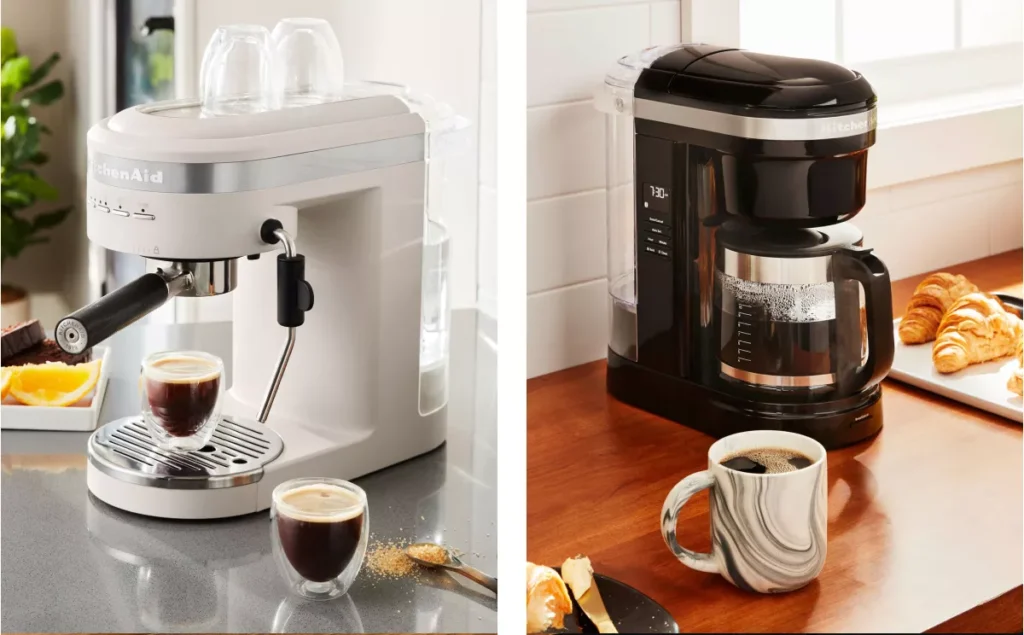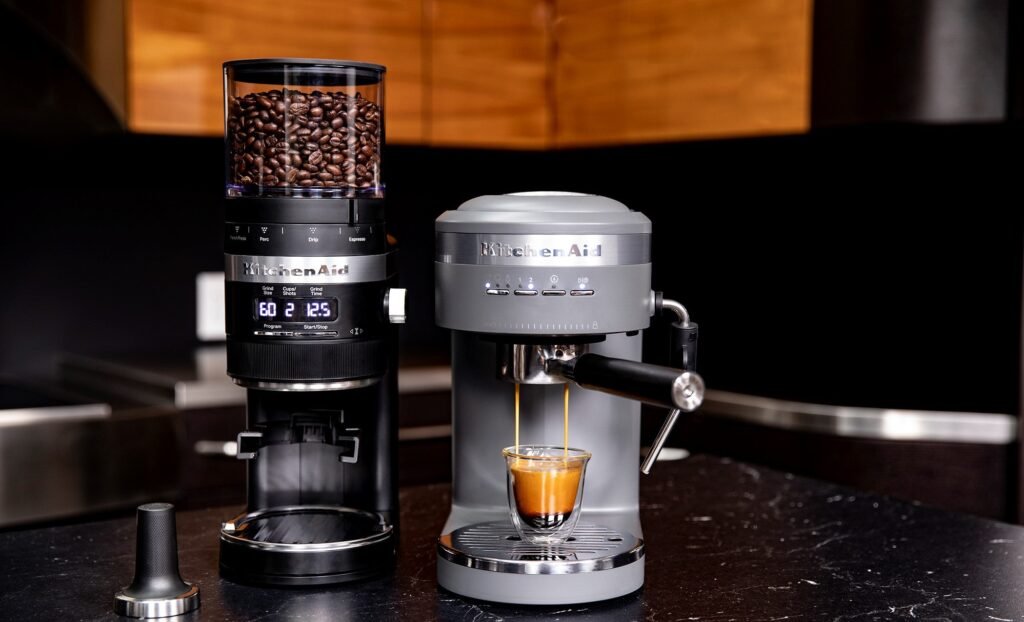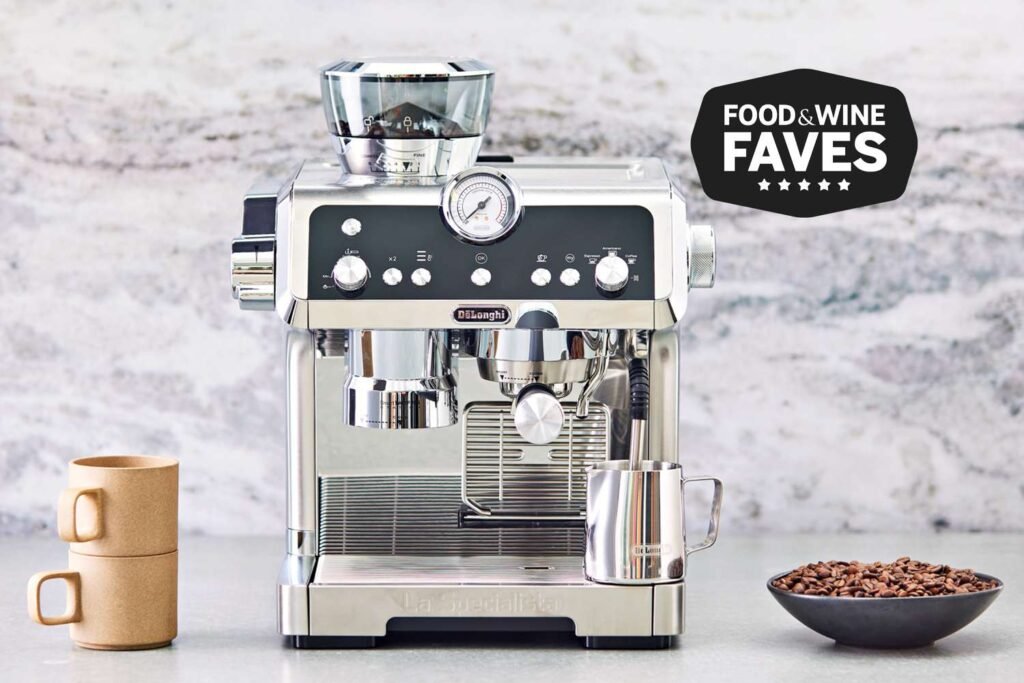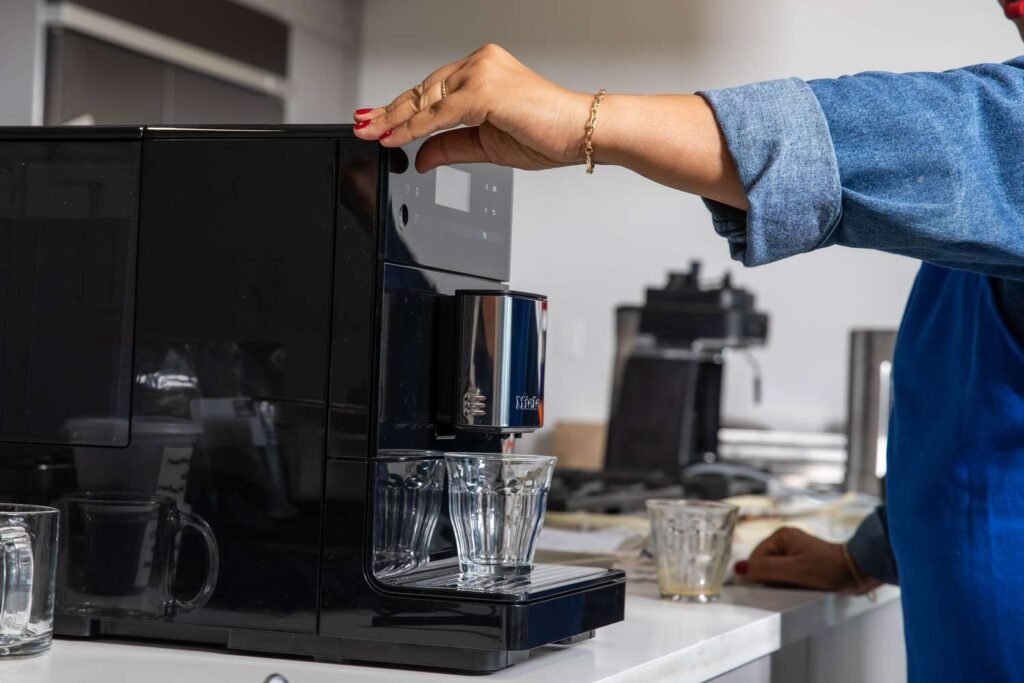Have you ever wondered about the difference between a coffee machine and an espresso machine with a grinder? Well, fret not, as this article aims to shed light on the distinctions between the two. While both machines serve the purpose of providing you with a delicious cup of joe, their functionalities and features diverge in significant ways. Whether you are a coffee enthusiast or someone exploring the world of espresso, understanding the disparities between these two types of machines will undoubtedly help you make an informed choice. So, let’s explore the intriguing differences between a coffee machine and an espresso machine with a grinder, and discover which one suits your preferences and needs the best.
Types of Coffee Machines
Automatic Drip Coffee Machine
An automatic drip coffee machine is one of the most common and popular types of coffee machines. It works by heating water and then slowly dripping it through a filter containing ground coffee beans. This method of brewing produces a full-bodied, flavorful cup of coffee. One of the advantages of an automatic drip coffee machine is its convenience – it typically has a built-in timer that allows you to set it up the night before and wake up to a fresh pot of coffee in the morning.
French Press
The French press, also known as a press pot or plunger pot, is a simple yet effective method for brewing coffee. It consists of a cylindrical glass or stainless steel container, a plunger with a mesh filter, and a lid. To use a French press, you add coarsely ground coffee to the container, pour hot water over it, and let it steep for a few minutes. Then, you press down the plunger to separate the grounds from the brewed coffee. This brewing method allows for full extraction of flavor and oils from the coffee grounds, resulting in a rich and bold cup of coffee.
Pour Over
Pour over coffee, also known as hand drip or filter coffee, is a brewing method that involves pouring hot water manually over coffee grounds. It typically requires a funnel-shaped device called a pour over dripper and a paper or metal filter. To make pour over coffee, you place the dripper on top of a cup or carafe, insert the filter, add coffee grounds, and then pour hot water over the grounds in a slow and controlled manner. This method allows for precise control over the brewing process and produces a clean, bright, and flavorful cup of coffee.
Moka Pot
The Moka pot, also known as a stovetop espresso maker, is a traditional Italian coffee brewing device. It consists of a bottom chamber for water, a middle chamber for coffee grounds, and a top chamber for the brewed coffee. To use a Moka pot, you fill the bottom chamber with water, add coffee grounds to the middle chamber, and assemble the pot. As the water heats up, it creates steam, which forces hot water through the coffee grounds and into the top chamber. The resulting coffee is strong, concentrated, and similar in flavor to espresso, although technically it is not true espresso.
Types of Espresso Machines
Manual Espresso Machine
A manual espresso machine, often called a lever espresso machine, is the oldest and most traditional type of espresso machine. It requires the user to manually control the brewing process by pulling a lever or pressing buttons to control the pressure and flow of water through the coffee grounds. This type of espresso machine provides the most hands-on and customizable brewing experience, allowing you to fine-tune the extraction and create personalized shots of espresso.
Semi-Automatic Espresso Machine
A semi-automatic espresso machine is the most common type of espresso machine found in homes and coffee shops. It combines manual control with automated features to make the brewing process easier and more consistent. With a semi-automatic machine, you have control over the grind size, dose, and tamping of the coffee, while the machine takes care of the water temperature and pump pressure. This type of machine gives you a balance of control and convenience, making it a popular choice for espresso lovers.
Automatic Espresso Machine
An automatic espresso machine takes convenience a step further by automating the entire brewing process. With an automatic machine, you simply select a preset recipe or input your desired settings, and the machine takes care of grinding the coffee, dosing it, tamping it, and extracting the espresso. This type of machine is ideal for those who want a consistently good shot of espresso without having to manually control every aspect of the process.
Super Automatic Espresso Machine
A super automatic espresso machine is the pinnacle of espresso machine technology. It combines the convenience of an automatic machine with additional features like built-in grinders, milk frothers, and programmable settings for different coffee drinks. With a super automatic machine, you can enjoy a wide range of espresso-based beverages at the touch of a button, from cappuccinos and lattes to macchiatos and flat whites. This type of machine is perfect for those who want a barista-quality espresso experience with minimal effort.

Coffee Machine Basics
Function
Coffee machines are designed to brew coffee, using different methods and technologies depending on the type of machine. They typically consist of a water reservoir, a heating element, a brewing chamber or carafe, and controls for adjusting brewing settings. The function of a coffee machine is to heat water to the appropriate temperature and then extract the flavors and aromas from the coffee grounds to produce a flavorful cup of coffee.
Grinding Options
Many coffee machines come with built-in grinders or give you the option to use pre-ground coffee. The grinding options vary depending on the type of machine. For example, automatic drip coffee machines usually require a medium grind size, while espresso machines require a fine grind size. Some machines also offer adjustable grind settings, allowing you to customize the grind size according to your preference.
Brewing Time
The brewing time of a coffee machine varies depending on the type of machine and the brewing method used. Automatic drip coffee machines typically take a few minutes to brew a full pot of coffee, while French press and pour-over methods require a longer brewing time of several minutes. Moka pots and espresso machines have shorter brewing times, usually around 20-30 seconds for a shot of espresso.
Water Temperature
Water temperature is an important aspect of coffee brewing as it affects the extraction of flavors from the coffee grounds. The ideal water temperature for brewing coffee is between 195°F and 205°F (90°C and 96°C). Most coffee machines are designed to heat the water to the optimal temperature for brewing, ensuring that you get the best possible flavors and aromas from your coffee.
Espresso Machine Basics
Function
Espresso machines are specifically designed to brew espresso, a strong and concentrated form of coffee. They use a combination of high pressure and hot water to extract the flavors and oils from finely ground coffee. Espresso machines typically consist of a water reservoir, a boiler or heating element, a pump, a brewing chamber or portafilter, and controls for adjusting brewing settings. The function of an espresso machine is to heat water to the correct temperature, build up the necessary pressure, and force the water through the coffee grounds to create a shot of espresso.
Grinding Options
Espresso machines require a fine grind size to ensure the proper extraction of flavors. Most espresso machines have built-in grinders or accommodate separate coffee grinders to grind the coffee beans to the desired fineness. Some machines also offer adjustable grind settings, allowing you to achieve the perfect grind size for your espresso.
Pressure
Pressure is a crucial factor in espresso brewing. Espresso machines use high pressure, typically between 9 and 15 bar (measured in atmospheres), to force the hot water through the coffee grounds. This pressure creates emulsification, which extracts the oils and flavors from the coffee, resulting in the characteristic crema and rich taste of espresso. The pressure is usually generated by a pump in modern espresso machines.
Shot Volume
The shot volume refers to the amount of espresso extracted by the machine in one brewing cycle. Espresso machines typically produce shots of espresso ranging from 1 to 2 ounces (30 to 60 milliliters), depending on the desired strength and size of the drink. Some espresso machines allow you to control the shot volume, enabling you to customize the strength and size of your espresso shots.

Features of Coffee Machines
Built-in Grinder
Some coffee machines come with a built-in grinder, allowing you to grind fresh coffee beans for each brew. This feature ensures maximum freshness and flavor in your coffee. It also eliminates the need for a separate coffee grinder and simplifies the brewing process.
Brewing Capacity
The brewing capacity of a coffee machine refers to the amount of coffee it can brew at once. Automatic drip coffee machines typically come in different sizes, ranging from single-serve to 12-cup capacities. French press, pour-over, and Moka pot coffee makers usually have a fixed brewing capacity based on their design.
Programmable Options
Many coffee machines offer programmable options, such as a built-in timer or pre-set brewing settings. These features allow you to set the machine to start brewing at a specific time or adjust the brewing strength and temperature according to your preferences. Programmable options provide convenience and customization, especially for those with busy schedules or specific taste preferences.
Milk Frothing
Some coffee machines, particularly those designed for specialty coffee drinks like cappuccinos and lattes, come with a built-in milk frother. These machines allow you to create creamy and frothy milk for delicious espresso-based beverages. The milk frother can be a separate attachment or an integrated component of the machine, providing you with the convenience of making a variety of coffee creations.
Features of Espresso Machines
Built-in Grinder
Similar to coffee machines, some espresso machines have a built-in grinder, which allows you to grind fresh coffee beans for each shot of espresso. This feature ensures maximum freshness and flavor, as freshly ground coffee is essential for a high-quality espresso. Built-in grinders provide convenience and consistency, eliminating the need for a separate grinder.
Pressure Profile Options
Advanced espresso machines offer pressure profiling capabilities, allowing you to control the pressure throughout the brewing process. This feature allows for experimentation and customization, as different pressure profiles can have a significant impact on the flavors and characteristics of the espresso. Pressure profiling gives you the ability to fine-tune the extraction and create unique and personalized shots of espresso.
Shot Volume Control
Some espresso machines allow you to control the shot volume, enabling you to adjust the strength and size of your espresso shots. This feature is useful for tailoring your coffee to your preferences and experimenting with different brewing ratios. Whether you prefer a single shot, double shot, or any other specific volume, shot volume control gives you the flexibility to make your espresso just the way you like it.
Milk Frothing
Espresso machines often come with a milk frothing option, which allows you to create creamy and frothy milk for specialty coffee drinks. Whether it’s for a classic cappuccino or a velvety latte, the ability to froth milk adds versatility to your espresso machine. The milk frother can be a steam wand or an automatic frothing system, depending on the machine’s design, providing you with the means to explore a wide variety of milk-based beverages.

Brewing Methods
Drip Brewing
Drip brewing is the most common method used by automatic drip coffee machines. It involves pouring hot water over coffee grounds in a filter and allowing the water to drip through, extracting the flavors and oils from the coffee. The brewed coffee then drips into a carafe or pot, ready to be served. Drip brewing produces a clean and consistent cup of coffee, making it a popular choice for everyday coffee drinkers.
Steeping
Steeping is the method used in French press and pour-over brewing. It involves combining coffee grounds and hot water in a container and allowing them to steep for a certain period, usually a few minutes. During this time, the flavors and aromas from the coffee grounds infuse into the water. Once the steeping time is complete, the liquid is separated from the grounds, resulting in a flavorful and full-bodied cup of coffee.
Percolating
Percolating is an older brewing method that uses a percolator, a pot with a chamber for water at the bottom and a vertical tube with a perforated filter basket in the middle. The water is heated, causing it to rise up the tube and percolate through the coffee grounds. The brewed coffee then flows back down into the bottom chamber, and the process is repeated until the desired strength is achieved. Percolating can produce a strong, robust cup of coffee but may result in over-extraction if not monitored closely.
Pressure Brewing
Pressure brewing is the method used by espresso machines. It involves heating water to the correct temperature and then forcing it through finely ground coffee at high pressure. The pressure, typically between 9 and 15 bar, extracts the flavors and oils from the coffee, resulting in a concentrated shot of espresso. Pressure brewing creates a rich and intense flavor profile that is distinct from other brewing methods.
Grinding Options
Burr Grinders
Burr grinders are considered the gold standard for grinding coffee beans. They consist of two abrasive surfaces, either flat or conical, that crush the coffee beans in a precise and consistent manner. Burr grinders offer a range of grind sizes, from coarse to fine, allowing you to achieve the optimal grind size for your brewing method. They produce a uniform particle size distribution, which leads to more even extraction and a better-tasting cup of coffee.
Blade Grinders
Blade grinders are the most common type of coffee grinders found in households. They use spinning blades to chop and grind the coffee beans into smaller particles. Blade grinders are generally less consistent in producing uniform grind sizes compared to burr grinders. However, they are more affordable and accessible for those who want to grind their coffee at home. Blade grinders are suitable for drip brewing methods and French press, but they may not be precise enough for espresso brewing.
Pre-Ground Coffee
Pre-ground coffee refers to coffee that has been already ground and packaged for convenience. It is the easiest and most accessible option for many coffee drinkers. However, pre-ground coffee lacks the freshness and flavor complexity that freshly ground coffee offers. It also limits your control over the grind size, which is crucial for achieving the best possible extraction. While it may be convenient, using pre-ground coffee may compromise the overall quality of your brewed coffee.

Advantages of Coffee Machines
Ease of Use
Coffee machines, especially automatic drip coffee machines, are designed to be user-friendly and require minimal effort to operate. They typically have straightforward controls and preset brewing options, making them ideal for those who want a quick and hassle-free cup of coffee. With just a push of a button or the setting of a timer, you can have a fresh pot of coffee ready to enjoy.
Brewing Large Quantities
One of the advantages of coffee machines, particularly automatic drip coffee machines, is their brewing capacity. They allow you to brew a large quantity of coffee in a single batch, making them suitable for gatherings, offices, or households with multiple coffee drinkers. You can easily brew enough coffee to serve a group of people without having to make multiple rounds of brewing.
Affordability
Coffee machines, especially basic models, are generally more affordable compared to espresso machines. They are available in a wide range of price points to suit different budgets. Whether you’re looking for a budget-friendly option or willing to invest in a high-end model with advanced features, there are coffee machines available at various price ranges, making them accessible to a broad range of consumers.
Versatility
Coffee machines offer versatility in brewing options, allowing you to choose from various brewing methods such as automatic drip, French press, pour over, or Moka pot. This versatility allows you to experiment with different coffee flavors and brewing techniques, catering to your preferences and providing a diversified coffee-drinking experience. You can switch between different brewing methods based on your mood or desired taste profile.
Advantages of Espresso Machines
Strong and Intense Flavor
Espresso machines are designed to produce a concentrated shot of espresso, known for its strong and intense flavor profile. The high pressure and short extraction time result in a bold and robust coffee that is distinct from regular brewed coffee. If you enjoy a more pronounced and complex flavor experience, espresso machines are the way to go.
Customization and Control
Espresso machines offer a high level of customization and control over the brewing process. You can adjust various parameters, such as the grind size, dose, and tamping pressure, to fine-tune the extraction and create your perfect shot of espresso. This level of control allows you to experiment with different brewing techniques and bean profiles, unlocking a world of possibilities in terms of taste and aroma.
Faster Brewing Time
Espresso machines are known for their fast brewing time. Unlike drip brewing methods that can take several minutes, espresso machines can extract a shot of espresso in a matter of seconds. This makes espresso machines ideal for those who want a quick caffeine fix or are on a tight schedule. With an espresso machine, you can enjoy a barista-quality shot of espresso without having to wait too long.
Milk-based Beverage Options
Espresso machines open up a world of milk-based beverage options, such as cappuccinos, lattes, macchiatos, and more. With the built-in milk frother or steam wand, you can easily create creamy and frothy milk for delicious specialty coffee drinks. Whether you prefer a silky latte or a velvety cappuccino, an espresso machine allows you to explore a wide range of milk-based recipes and elevate your coffee experience.

